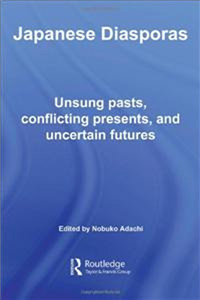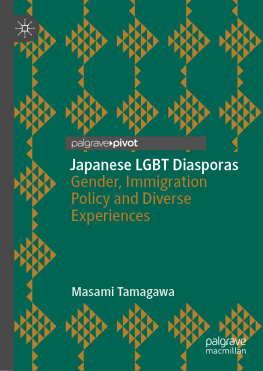Acknowledgments
Early versions of most of the chapters in this book were presented at several sessions at the panel Unsung Pasts, Unimaginable Futures, and the Ongoing Negotiations of Human Rights: Japanese Transnational Migrants and Their Descendants in a Globalized World at the 101st Annual Meeting of the American Anthropological Association in 2002. We are very grateful to the following organizations for sponsoring these sessions: the Society for Urban, National, and Transnational/Global Anthropology, the Society for East Asian Anthropology, and the Society for the Anthropology of North America.
Many people worked hard to make this book possible, especially the contributors, to whom I owe a great debt for all their support and encouragement. However, I want to thank especially Mark Selden, Harumi Befu, and Rosemary Carstens who all went beyond the call of duty or obligations of friendship or colleagueship in helping me make this project a reality.
1 The Japanese diaspora in the New World
Its Asian predecessors and origins
Roger Daniels
The purpose of this chapter is to outline the beginnings of the Japanese diaspora and to summarize the development of Asian immigration to the Caribbean, Hawaii, the United States, and Canada.1 To understand the Japanese diaspora in the New World it is useful first to consider the prior migration of other Asians, chiefly from China, to various parts of the plantation world beginning early in the nineteenth century. The British civil servant and scholar Hugh Tinker (1974) has called this migration a new system of slavery, in which Asians, mostly indentured, were used as surrogates for enslaved Africans at a time when first the Atlantic slave-trade and then slavery were being outlawed. There had been a fragmentary migration of East Asians to the New World as early as the seventeenth century. Spanish and Nahuatl texts describe both Chinese and Japanese in early seventeenth-century Mexico, who came as supercargoes on the fabled Manila galleons. Chinese seamen were present in American east coast ports in the years immediately after the American Revolution, followed by the occasional merchant (Nuttall 1906; Brun-house 1940; Schurz 1959; Leon-Portilla 1981; Calvo 1983). These and other migrations from Asia involved very few individuals, probably fewer than a hundred before 1800.
The Chinese diaspora in the New World to the 1920s
Early in the nineteenth century the nature and size of Asian migration changed radically. Even before the end of the slave-trade some British writers, seeing the handwriting on the wall, suggested using indentured Chinese to replace enslaved Africans. As one naval officer put it, Chinese came from the best cultivated country on Earth, were inured to a hot climate, and very industrious. He might have added that the peoples of South China had long migrated into Nanyang (Southeast Asia). What became known as the Chinese coolie trade began in 1806 with a shipment of 200 Chinese indentured laborers to Trinidad.2 Eight of them - 4 percent died in transit, a rate that remained fairly constant in the trade from China to the British Caribbean, although in one bad year, 1853,189 of 1,824 who left Chinese ports for the West Indies died at sea, more than 10 percent (Higman 1972; Lai 1993: 292, table 23).
As was the case in most nineteenth- and early twentieth-century international migration, these and later indentured laborers were chiefly adult males; a recent careful estimate of Chinese brought to Jamaica between 1860 and 1884 judges that about 15 percent were female. Nearly 200,000 Chinese were brought to the Caribbean, some 150,000 of them to Cuba; perhaps 18,000 went to the British Caribbean islands, chiefly Jamaica; about 2,500 to the Dutch colonies, and a smaller number to Central America. Chinese workers were never a very significant factor in the contract labor force within the British Empire in the Americas (Mintz 1985),3 but they were of great importance in four different parts of the New World. Indentured Chinese immigrants played major economic roles in Cuba, Peru, and Hawaii; Chinese workers also played a major role in the Canadian and American West where indentured labor existed only among Native Americans in thrall to Spanish Mexican missions. Except in North America, the sugar plantations absorbed most of their labor.
The treatment of Chinese in Cuba was quite harsh and their indenture existed alongside African and Afro-Caribbean slavery until 1886. The importation of Chinese began in 1847, broke off for six years, and recommenced in 1853. From then until 1874, laborers more than 90 percent of them male left China for Havana every year: a total of 150,000 Chinese. An investigatory commission set up by the Chinese government concluded in 1870 to 1871 that of the Chinese laborers who have proceeded to Cuba, 8 or 9 of every 10 have been conveyed there against their will. It estimated a voyage mortality rate of some 11 percent; more than 16,000 Chinese died en route to Cuba (Helly 1993: 38, 42). The conditions under which the Chinese worked in Cuba can only be described as barbaric: Robert L. Iricks (1982: 300) judgment that nothing in the slave trade literature reads worse than the accounts of maltreatment in Cuba is surely an overstatement, but not by much. The mortality rate within Cuba was quite high from accidents and illness. In addition, the Cuba Commission reported in 1876 that some 500 Chinese were committing suicide every year (cf. Pastrana 1983).
Conditions in Peru were probably worse. Most of the 80,000 to 100,000 Chinese who were brought there between 1849 and 1875 worked on sugar and cotton plantations, but a particularly wretched minority, perhaps one-fifth and all male, were put to tasks on Perus guano islands where apparently most were simply worked to death. The shipboard mortality rate - as high as 41 percent in some terrible years seems to have averaged about the same 11 percent that prevailed on the longer trip to Cuba. Chinese mortality in continental Peru also ran high, although there are no good data. A Lima newspaper reported in 1871 that: The greatest part of those being newly contracted by the plantations are coming to replace, not those who are completing their contracts, but rather those who died fulfilling them (Stewart 1951: 105; see also Gonzales 1985).
There are many common factors in the Chinese presence in the Caribbean and Peru. They had no provision for return transportation in their indentures as did contract laborers from India and, unlike the case in Hawaii or North America, no sizable number is believed to have returned to China, although a few economically successful returnees are reported as early as the 1860s (Lai 1993: 203). Chinese in Trinidad moved quickly away from the plantations and into small-scale market gardening and eventually into commerce. In British Guiana, where Portuguese occupied most of the petty producer niches, the move from the plantation was less rapid, but it occurred. As Clementi pointed out, there were some spectacular economic success stories among the British Guiana Chinese, but the overall picture is one of steady population decline, caused by the absence of Chinese women, emigration to other parts of the Caribbean, and entry, often illegal after 1882, into the United States (Clementi 1915).
By the early twentieth century there was at least a small Chinese presence everywhere in the hemisphere. Large numbers of Chinese were merchants, shopkeepers, and entrepreneurs. (Many of these came direct from China.) And, as is so often the case with what some style middlemen minorities, Chinese were often the targets of nativists. This was nowhere more true than in Mexico, where, by 1910, there were some 13,000 Chinese. To note merely the bloodiest incident, some 300 Chinese in a community of about 400 in the northern Mexican city of Torreon were massacred in one bloody night in 1911 by revolutionary troops under Francisco Villa (Jacques 1974: 233-46).4
Next page




